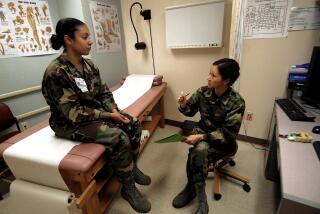Survey Shows That Clothes Do Make the Doctor
- Share via
Doctors in blue jeans make patients a bit uneasy but physicians in tennis shoes are OK and the traditional white coat is still de rigeur , according to a bicoastal survey of patient and doctor attitudes on dress and courtesy.
The survey, conducted at Boston’s Brigham and Women’s Hospital and San Francisco’s H. C. Moffitt Hospital, focused on attitudes of patients and intern and resident physicians; 200 patients and 74 doctors were questioned. The survey was published in the Journal of the American Medical Assn.
Among the patients, 55% agreed that a doctor should wear a white coat when seeing them, though 48% figured it was acceptable for doctors to wear tennis shoes (27% didn’t care). Yet 47% felt male doctors should wear neckties when they see patients, and 34% thought female doctors should wear skirts. Blue jeans drew a 63% negative vote.
Forty percent of the patients preferred that their doctors call them by their first names, and only 18% stated a clear preference for being addressed by their last names.
Of the doctors questioned, 28% always wore a white coat, 49% sometimes did and 23% eschewed the tradition. Eighty-five percent of male doctors said they always wore ties; 57% said they never wore sneakers; 68% of the women physicians said they wore skirts only “sometimes,” and an overwhelming 91% denied ever wearing blue jeans.
Doctors See Boom in Fertility Field
There’s a certain generational irony to contemporary childbearing, and two doctors at the Columbia University College of Physicians and Surgeons aren’t able to resist taking note of it. It’s a phenomenon that is turning into a bonanza for fertility specialists.
At issue is what the two physicians say is a societal conflict that has arisen because women of the baby-boom generation were the first to be preoccupied with fertility regulation permitted by the advent of reliable forms of birth control. They spent a great deal of their teens and 20s trying not to be pregnant.
Now, observe Drs. Paul Gindoff and Raphael Jewelewicz in the journal Fertility and Sterility, baby boomers--having gotten to their late 30s and early 40s childless--are arriving in droves at the offices of fertility specialists because they are having difficulty getting pregnant.
Though menopause does not occur until, on the average, about age 50, Gindoff and Jewelewicz note that fertility begins to diminish a decade before that. Even such social factors as a decline in the frequency of intercourse between ages 20 and 40 influences the reality that today’s women are trying to compress their reproductive lives into ever shorter numbers of years.
As a consequence, fertility problems requiring medical intervention are increasing--and the burgeoning fertility field is probably only seeing the start of a period of intense prosperity, the two doctors imply. In just the five-year period from 1976 to 1980, fertility-related problems increased from 95.6 of every 100,000 doctors office visits to 101.9.
Med School Standards
Dr. Sanford Brown, head of the Mendocino Foundation for Health Education, says he wrote his latest book, “You CAN Get into Medical School,” with the idea of attracting potential medical students like himself: “a college English major with a mediocre grade-point average, abysmal Medical College Aptitude Test scores and no premedical courses.” Reminds Brown: “I was, nevertheless, admitted.’
And in concert with these doubts about how would-be doctors are selected, a new study from the Texas Tech University School of Medicine finds that 50 medical students who had initially been rejected by the admissions committee and 150 who were accepted by the traditional process showed no significant differences in academic performance.
The finding, six Texas Tech researchers noted, appears to indicate that the traditional selection process “does not enhance the ability to predict performance of medical school applicants.”
Doctors’ Lexicon
If you watch movies or television shows that dramatize medicine even occasionally, you’ve probably heard the urgent command to “type and crossmatch” blood for a transfusion.
Typing blood--determining which of four blood groups (A, B, AB and O) a sample may belong to--is fairly well understood.
Crossmatching is not nearly so well known. Even if two people have the same blood type, the blood from one may not be suitable for transfusion into the other, because individual characteristics of the red cells and other blood components may still be incompatible.
Thus, in crossmatching, the compatibility of the same-type blood from two people is verified before a transfusion of blood of a suitable type is attempted.






